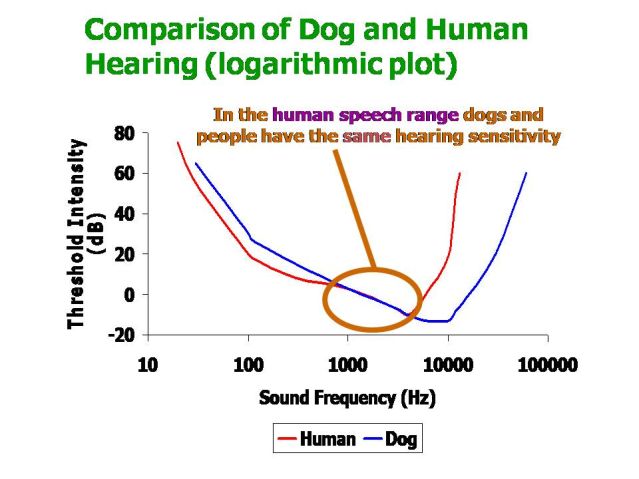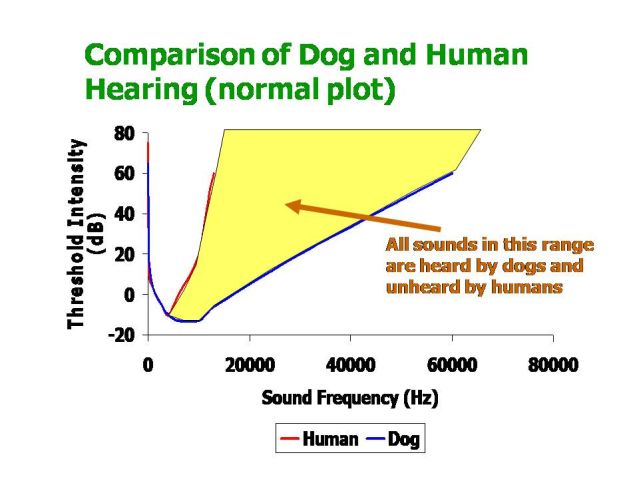Animal Behavior
How Good Is a Dog's Hearing Compared to Humans?
Dogs can hear specific sounds better than a human does, and vice versa.
Posted July 7, 2024 Reviewed by Lybi Ma
Key points
- Two dimensions of sounds that make a difference are intensity (loudness) and frequency (pitch).
- Humans can hear some low-frequency sounds better than dogs.
- Humans and dogs have the same hearing sensitivity for sounds that fall into the range of normal human speech.
- Dogs have vastly superior hearing sensitivity for high-frequency sounds compared to humans.

My dog Ranger gives a short sharp bark and looks at the front door. My wife responds, "There goes the doorbell." Of course, the doorbell has not sounded, and will not for another minute or so, it's just that my dog has heard something outside near the door, something that our human hearing could not yet sense.
The widespread belief is that dogs have much greater hearing sensitivity than humans. The truth is that it depends on the specific sounds being considered. For some sounds humans hear better, for some sounds there is no difference between us and our dogs, while for a broad range of different sounds, the canine auditory system is much more acute.
The Nature of Sounds
Two important physical dimensions of sound make a difference. Sound intensity, which corresponds to loudness, is measured in decibels (dB). The decibel is a unit used to measure sound level. A young human can barely hear zero decibels. Technically this is called the absolute sound threshold. Some typical sound intensities are an ambulance siren, which will be about 120 dB, an average conversation will be around 50 dB, and normal breathing will be a quiet 10 dB.
The second dimension is frequency, which we sense as sound pitch (high or low). It corresponds to the number of cycles per second that a sound wave goes through. The measure is hertz (Hz). A low-frequency sound will be sensed as a low pitch (like a tuba) while higher Hz will be heard as a higher pitch (like a bird chirping).
How to Compare Canine and Human Hearing
Before we can consider the differences in the hearing ability of dogs and people, it would be useful if you understood how to read a basic audiogram, such as the one below. Along the bottom (horizontal) axis, we are going to plot the frequency of the sound (Hz ), while on the vertical axis, we are plotting the minimum sound intensity (dB) needed to hear that sound. In this figure, the red line represents the hearing ability of humans, while the blue line represents the hearing ability of dogs. The key to reading this is that all sounds above the lines are heard, while all sounds below the line can't be sensed.

Looking at the figure, it should be clear that canine and human sound sensitivity depends upon the frequency. Sounds that have too low or too high frequency are difficult to hear. There is also a lot of overlap between the hearing abilities of dogs and humans. The main differences are that people are somewhat more sensitive to lower-frequency sounds and dogs are more sensitive to higher-frequency sounds.
When Dogs and Humans Have the Same Sensitivity
Human ears are tuned to sounds that are important in our lives. Sounds between 500 and 4,000 Hz are important because they are the frequencies most critical for hearing and decoding speech. The best sensitivity for the human ear is right in the middle of that speech range, around 2,000 Hz. Looking at the figure below we have circled the human speech sound range. Dogs and humans have virtually the same hearing sensitivity for the spoken sounds of human speech.

Dogs Have a High-Frequency Advantage
The most typical audiograms, such as the ones we have been looking at here, use a logarithmic plot to squeeze the higher numbers down to a manageable range and make the lower values more visible. If we use a normal plot we can see how much greater a dog's hearing sensitivity is for the high frequencies. This is what we have done here (although we will no longer be able to see the low-frequency differences when we do this). Dogs can hear a vast range of high-frequency sounds simply beyond human hearing.

To give you an idea of what this means in practical terms, the highest note on a standard 88-key piano is 4186 Hz. To reach the note, the highest frequency a human can hear, the right side of the piano would have to be extended by 28 keys. For the highest note that a dog can hear, the keyboard would have to be extended by 52 keys and the notes sounded by these last 24 keys would all be completely beyond human hearing ability.
It's All About Evolution
Why did dogs develop such a better high-frequency sensitivity compared to humans? It has to do with the evolutionary history of their wild ancestors. Although wolves, jackals, and foxes might hunt medium to large animals, they often prey on small animals, like mice, voles, and rats. These animals make high-pitched squeaks and their scrabbling around in the leaves and grass produces high-frequency rustling and scraping sounds. The ability to hear the high-frequency sounds that these little creatures make is, therefore, a matter of survival, and it is likely that only those canines that developed high-frequency hearing abilities endured and prospered. Cats, whose entire sustenance may depend on small rodents, can hear sounds five to ten thousand hertz higher than dogs.

Can You Hear the Difference?
Now we have seen that the best sensitivity for a person's hearing is in the 2000 Hz range (tuned for human speech). In contrast, the maximum sensitivity of a dog is tuned much higher, at about 8,000 Hz, at which our human hearing ability has already begun to drop off. Although I can't give you a pair of canine ears to experience how our sensitivity drops off with higher frequencies relative to dogs, we can demonstrate it with a trick. You can hear this difference in hearing capacity for yourself if you make a shh sound, drawing out its length as if you were trying to signal someone to be quiet. For most people, the shh sound has a dominant frequency just a bit above 2,000 Hz, which the human ear is tuned for. Now make a sss sound, as though you were trying to imitate the hissing of a snake. For most humans, this sound has a dominant frequency below 8,000 Hz, where the dog’s ear is most sensitive. For the same amount of effort, the shh sound sounds louder than the sss sound, mainly because we are less sensitive to such higher-frequency sounds. But for the dog, the sss will sound louder than the shh.
Dogs' skill at hearing ultrahigh frequency sounds, which are well beyond human perception, may give canines certain unexpected abilities currently being researched—such as the capacity to predict certain earthquakes.
Copyright SC Psychological Enterprises Ltd. May not be reprinted or reposted without permission.
References
Barber, A. L. A., Wilkinson, A., Montealegre-Z, F., Ratcliffe, V. F., Guo, K., & Mills, D. S. (2020). A comparison of hearing and auditory functioning between dogs and humans. Comparative Cognition & Behavior Reviews, 15, 45–80. https://doi.org/10.3819/CCBR.2020.150007
Coren, S. (2004). How dogs think: Understanding the canine mind. New York: Free Press (pp. i – xiv, 1-351).
Coren, S. (2006, November). Can dogs detect earthquakes? A possible auditory answer. Paper delivered at the Psychonomic Society meetings Houston, Texas.




